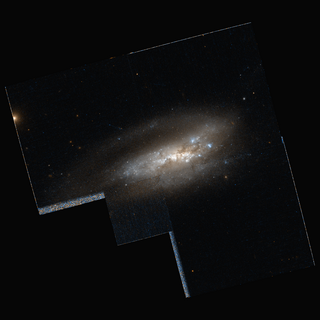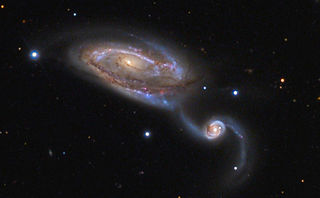
The Atlas of Peculiar Galaxies is a catalog of peculiar galaxies produced by Halton Arp in 1966. A total of 338 galaxies are presented in the atlas, which was originally published in 1966 by the California Institute of Technology. The primary goal of the catalog was to present photographs of examples of the different kinds of peculiar structures found among galaxies.

NGC 5921 is a barred spiral galaxy located approximately 65 million light-years from the Solar System in the constellation Serpens Caput. It was discovered by William Herschel on 1 May 1786. In February 2001 a type II supernova was discovered in NGC 5921. It is a member of the Virgo III Groups, a series of galaxies and galaxy clusters strung out to the east of the Virgo Supercluster of galaxies.

NGC 3041 is an intermediate barred spiral galaxy located in the constellation Leo. It is categorized as SAB(rs)c in the galaxy morphological classification scheme. It was discovered by William Herschel on 23 March 1784. The galaxy is approximately 77 million light years away from earth.

NGC 5256 is an object that contains two disc galaxies, that are colliding into each other. It is located in the constellation Ursa Major, and was discovered by William Herschel on 12 May 1787. The two nuclei of the galaxies are separated by about 13,000 light-years. The southwest and northeast nuclei have masses of 7×109 M☉ and 10×109 M☉, assuming they orbit around a common center of mass. NGC 5256 is located at about 420 million light-years away from the Earth.

NGC 6000 is a barred spiral galaxy located in the constellation Scorpius. It is designated as SB(s)bc in the galaxy morphological classification scheme and was discovered by John Herschel on 8 May 1834. The galaxy is approximately 103 million light-years away. It is the brightest of all the galaxies in the constellation Scorpius.
Two supernovae have been observed in this galaxy, namely 2007ch and 2010as, each having a mag. of about 17.2 and 15.5 respectively.

NGC 6104 is a barred spiral galaxy located in the constellation Corona Borealis. It is designated as S(R)Pec in the galaxy morphological classification scheme, though it is clearly a barred spiral, and was discovered by William Herschel on 16 May 1787. The galaxy is approximately 388 million light-years away.

NGC 6181 is a barred spiral galaxy located in the constellation Hercules. It is designated as SB(rs)c in the galaxy morphological classification scheme and was discovered by William Herschel on 28 April 1788. The galaxy is 107 million light years away.

NGC 6207 is a spiral galaxy located in the constellation Hercules. It is designated as SA(s)c in the galaxy morphological classification scheme and was discovered by William Herschel on 16 May 1787. NGC 6207 is located at about 30 million light-years from Earth. It is located near the globular cluster Messier 13.

NGC 6212 is a spiral galaxy located in the constellation Hercules. It is designated as Sb in the galaxy morphological classification scheme and was discovered by the French astronomer Édouard Stephan on 26 July 1870. NGC 6212 is located at about 397 million light years from Earth.

NGC 6221 is a barred spiral galaxy located in the constellation Ara. In de Vaucouleurs' galaxy morphological classification scheme, it is classified as SB(s)bc and was discovered by British astronomer John Herschel on 3 May 1835. NGC 6221 is located at about 69 million light years from Earth.

NGC 6239 is a barred spiral galaxy located in the constellation Hercules with a distinct core. It is designated as SB(s)B in the galaxy morphological classification scheme and was discovered by the German-born British astronomer William Herschel on 12 April 1788. The galaxy is approximately 42 million light years away from Earth.

NGC 6300 is a barred Seyfert spiral galaxy located in the constellation Ara. It is classified as SB(rs)b in the galaxy morphological classification scheme and was discovered by the Scottish astronomer James Dunlop on 30 June 1826. NGC 6300 is located at about 51 million light years away from Earth. It is suspected that a massive black hole may be at its center, pulling all the nearby objects into it. In turn, it emits large amounts of X-rays.

NGC 6328 is an intermediate spiral galaxy located in the constellation Ara. It is classified as SAB(s)ab in the galaxy morphological classification scheme and was discovered by the British astronomer John Herschel on 2 May 1835. NGC 6328 is located at about 199 million light years away from Earth.

NGC 6394 is a barred spiral galaxy located in the constellation Draco. It is designated as SBb in the galaxy morphological classification scheme and was discovered by the American astronomer Lewis A. Swift on 7 July 1885.

NGC 5640 is a spiral galaxy approximately 660 million light-years away from Earth in the constellation of Camelopardalis. It was discovered by British astronomer William Herschel on December 20, 1797.

NGC 5774 is an intermediate spiral galaxy approximately 71 million light-years away from Earth in the constellation of Virgo. It was discovered by Irish engineer Bindon Stoney on April 26, 1851.

NGC 5609 is a spiral galaxy located 1.3 billion light-years light-years away from Earth, in the constellation Boötes. It has the second largest redshift of any galaxy in the New General Catalogue. Only NGC 1262, another spiral galaxy, has a higher redshift. NGC 5609 was discovered by astronomer Bindon Blood Stoney on March 1, 1851.

NGC 5395 is an interacting spiral galaxy located at a distance of 160 million light years, but receding away from the Earth at 3511 kilometers per second, in the constellation Canes Venatici. It was discovered by William Herschel on May 16, 1787. NGC 5395 and NGC 5394 are included in the Atlas of Peculiar Galaxies as Arp 84 in the category "Spiral galaxies with large high surface brightness companions".

NGC 5678 is a barred spiral galaxy in the constellation Draco. It was discovered by William Herschel on April 17, 1789.



















